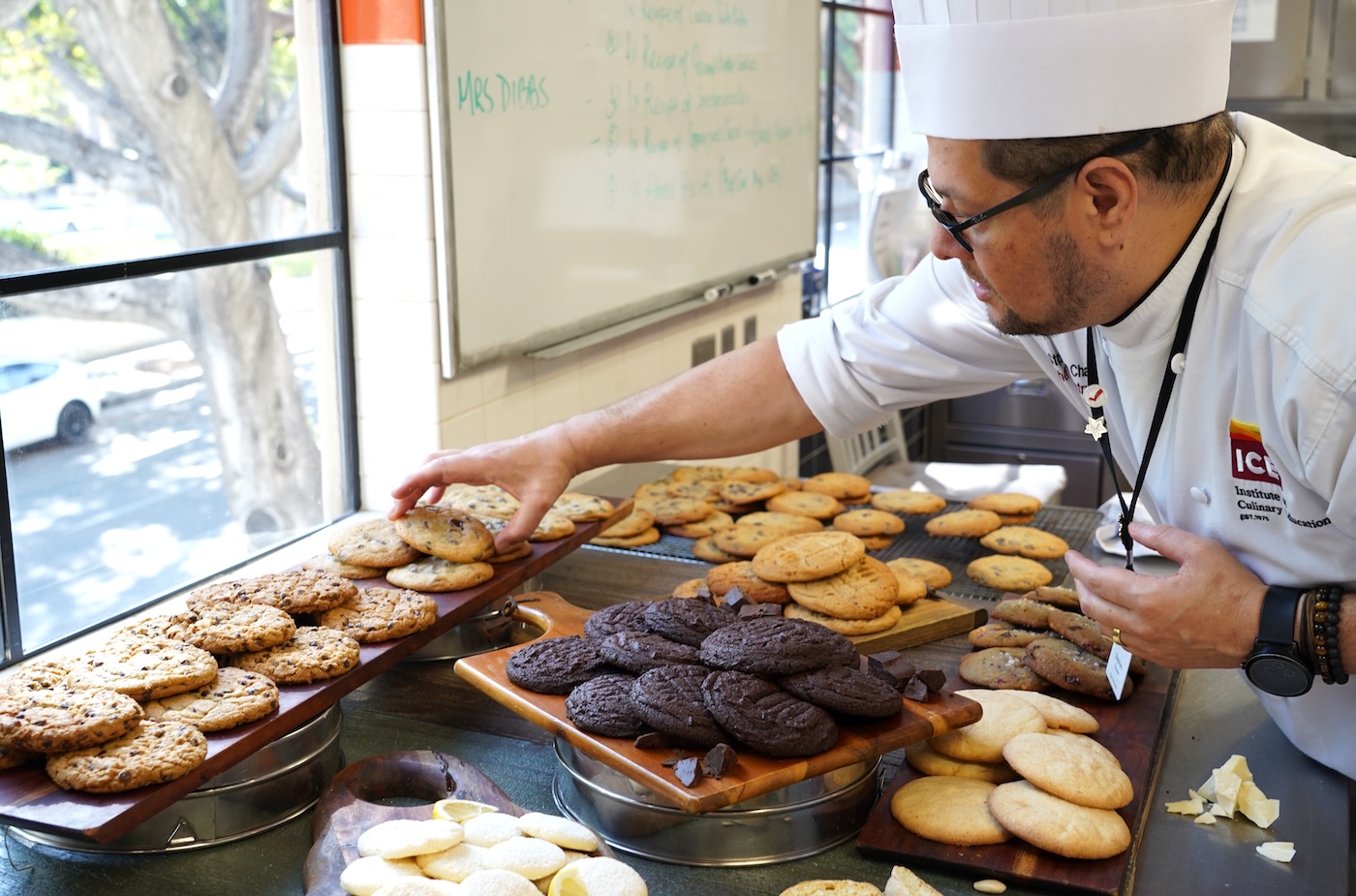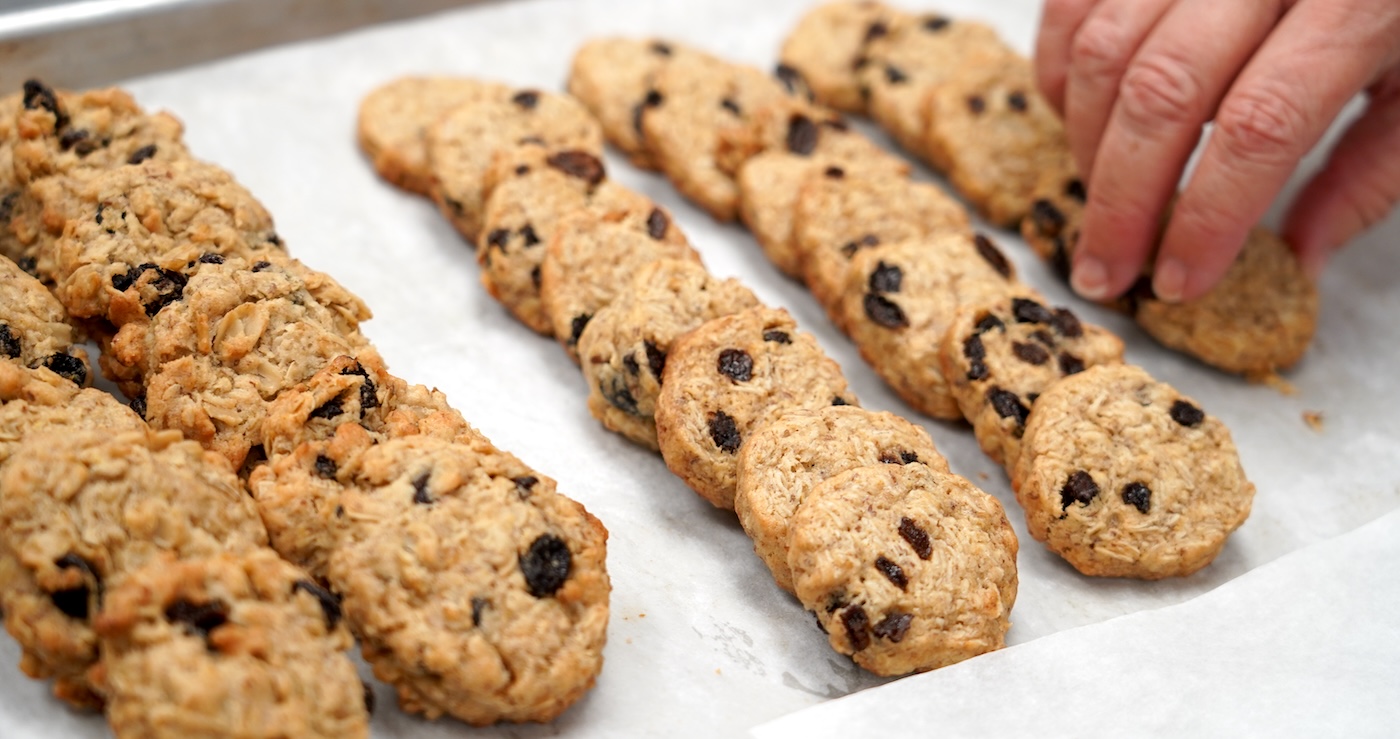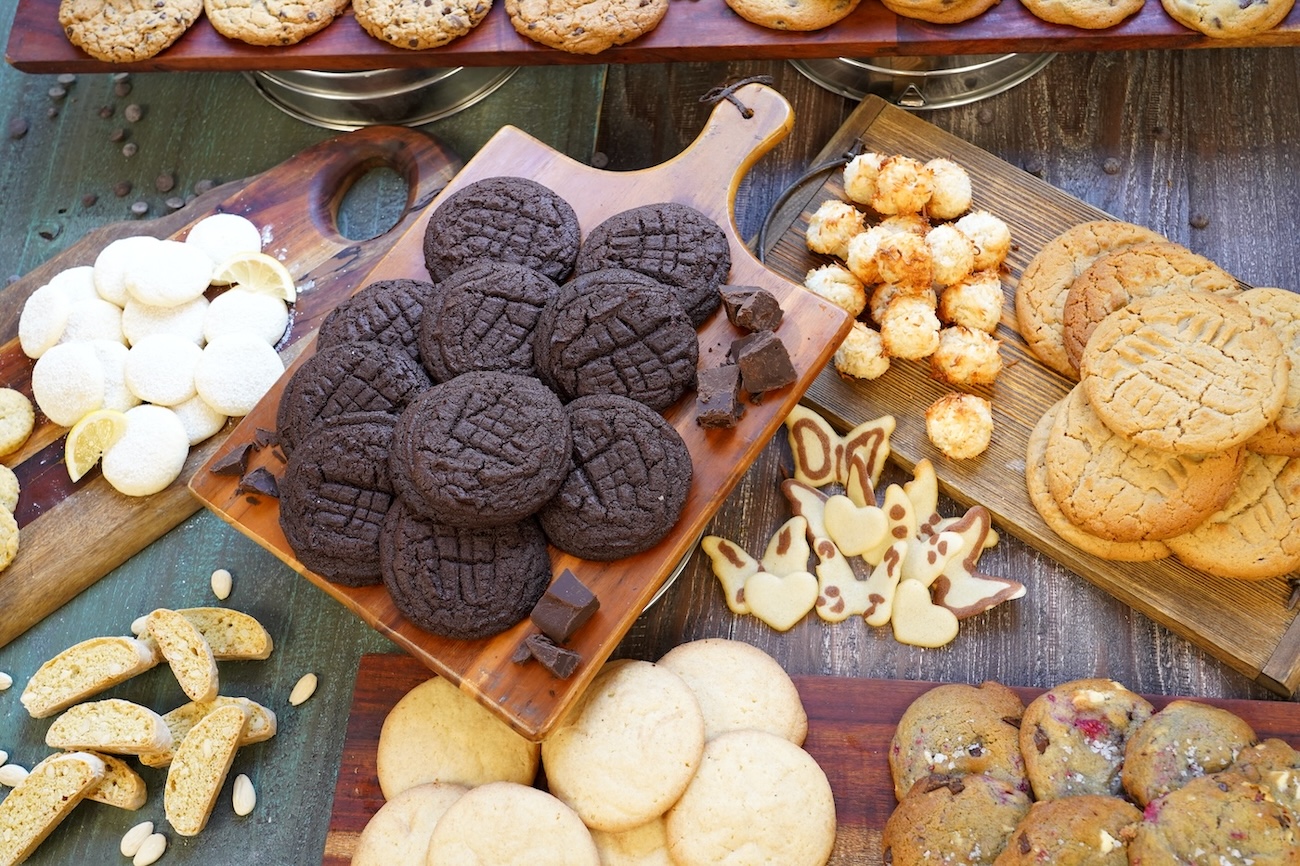Cookies are a classic baked treat.
Whether you’re whipping up a batch from scratch or utilizing refrigerated cookie dough, in theory, you can enjoy a fresh cookie, still warm from the oven, in about 20 to 30 minutes time from start to finish.
Few other baked goods can claim that kind of efficiency when it comes to satisfying a craving for something sweet. Plus, they're professionally significant: ICE Pastry & Baking Arts students learn about cookies early on in their classes, since the beloved dessert is so fundamentally important in the baking world.
Many baked goods have some proportion of sugar, flour, butter and eggs in their basic formula, along with a rising agent, so what makes a cookie uniquely a cookie, rather than a muffin or cake? Cookies can be dense or airy, chewy or crispy, flat or puffy — what variables in the basic formula create different outcomes in the shape and texture of cookies? In short, have you ever thought about the science of cookies?
Understanding the science of cookies can improve your baking skills, or even just simply add to your enjoyment of them. ICE Senior Chef-Instructor Stephen Chavez talks us through the science of what happens when you put your cookies in the oven, and how variations in ingredients and techniques can produce different outcomes.

Cookies: The Baking Process
For understanding cookie science, it’s actually helpful to begin near the end of the process. Knowing what happens when your cookie goes into the oven can help inform your understanding of the individual elements that go into the cookie dough, and how best to mix them.
When your cookies go into the oven, there are several things that are happening scientifically, according to Chef Stephen.
“Your proteins are coagulating," he says. "Your starches are gelatinizing. Your fats are melting. Your moisture is evaporating. Your sugars are caramelizing, which leads to browning. The gas is expanding, and things are rising.”
Once out of the oven, as your cookies cool, the previously liquified ingredients begin to harden or solidify, and the cookies deflate slightly due to the cooling of the air inside of them as well.
If you peek into the oven while cookies are baking, you won’t see these processes happen one after the other, however.
“It all works in tandem,” Chef Stephen says. “So when the fats melt, the fat turns into a liquid and the liquid evaporates, which becomes a steam. Steam rises, which makes your cookies pop up. It doesn't matter whether it’s a cookie or a piece of steak. It all happens exactly the same. Cooking is cooking, and physics is physics.”
Understanding this, next let’s examine some of the major players in the cookie dough mixture for their possible effect on the outcome, depending on the products you use, as well as the treatment of those components.
Butter: Creamed, Melted or Browned
Different recipes frequently call for different butter treatments, which have a major impact on texture, and in certain cases, on flavor. Melted butter will result in a fudgier texture, whereas creamed butter will allow a little more air into your cookie. (Brownies, for example, almost always call for melted butter.)
“In general, most of the time we want to use the creaming method,” says Chef Stephen, “which is not only softening the butter but along with the sugar is putting little air pockets in it, which adds to the little bit of leavening that you need for your cookies to rise.”

As for browned butter, whether you add it melted or let it cool and solidify somewhat, it's all a matter of taste. As an ingredient, browned butter adds a nutty, enhanced caramel flavor to the cookie.
“Cook’s Illustrated’s chocolate chip cookies are famous for having brown butter — and it's a delicious cookie,” he says.
Related: Key Ingredient: Butter
White Sugar Versus Brown Sugar
Consider your basic chocolate chip cookie recipe, which tends to have both white sugar and brown sugar in the recipe. This isn’t necessarily a matter of flavor, but more so one of texture.
“The more white sugar you have, the more crispy your cookie will be. The more brown sugar you have, the softer your cookie,” Chef Stephen says.
This has to do with the moisture content of the different sugars. This is especially important to consider if you’re faced with making ingredient substitutions if you’re out of one kind or another. As brown sugar is made with molasses, which is a sugar syrup, it has more water content. Raw sugar, on the other hand, is a type of unrefined sugar but is not the same as brown sugar, as it doesn’t contain molasses and its related moisture content.
Related Recipe: Foolproof Sugar and Gingerbread Cookies
Differences in Flour
Most of us probably have all-purpose flour in our cupboards as a go-to option. AP flour is an ideal flour for cookies because it results in a pleasantly chewy texture, rather than dense or cakey cookies.
“AP flour will work perfectly pretty much every time,” Chef Stephen says. “Just don't get self-rising flour or anything like that,” he says. “I don't get anything that adds ingredients — just stick to straight flour.”
Related: Choosing the Best Flour for Bread Baking
If you have other flours on hand, they’ll work, but you shouldn’t expect the same outcome.
“Bread flour has the most protein content, so your cookies will probably end up a little bit on the tougher side,” Chef Stephen says. “Cake flour has the lowest protein of any flour. So with cake flour, the cookies will be soft, and they may even be crumbly.”

Baking Soda Versus Baking Powder
You’ll notice that most cookie recipes call for baking soda rather than baking powder, so it’s important to understand the reason why if you’re considering making a substitution.
“Baking soda is gonna give you a little pop, which is why you use it mostly for cookies,” Chef Stephen says. “Baking powder is when you want a bigger pop, like for cake or muffins.”
Baking powder is considered “double acting,” where it activates with both moisture and heat. It will begin developing in the bowl as the ingredients come together, and continue working in the oven to give your baked goods a big rise.
Unless you specifically want puffy cookies, baking soda is the way to go. “Baking soda simply requires an acid to activate,” Chef Stephen explains, which can be found in several ingredients in the cookie: salt, for example, and even chocolate.
Mixing the Dough
How you build the cookie dough also has a scientific impact on its outcome. Very few (if any) cookie recipes call for you to put everything in a mixer all at once. Typically, butter and sugar are creamed together, then additional liquids are added, then dry ingredients. How you handle each step can have an impact.
“One thing I teach my students every time is with the creaming method, combining the fat and the sugar, you can mix that as long as you want, you can make that light and fluffy and airy and creamy,” Chef Stephen says, “but after that, for the remaining ingredients it’s just about mixing enough until they come together.”
This is especially important with the eggs, which should be lightly beaten first before being added to cookie dough, so they can be easily incorporated into the mixture.
“If you whip up your eggs with a bunch of air, you're going to have big cakey cookies,” Chef Stephen says.
The goal with adding the dry goods is not to overly develop the gluten content in the flour.
“Flour plus moisture equals gluten,” Chef Stephen says. “We don't want our cookies to be tough. We want them to be tender. So I want that flour to mix until it's just combined. And then if I'm adding in chocolate chips or nuts or anything like that, then I'll put those in and just stir them through and that's it.”

Resting the Dough
While you definitely can have fresh cookies baked in under 20 minutes, there is a scientific rationale for making yourself wait, even just an extra half hour.
“One of the most important things when it comes to cookies is the controlling of the temperature of the fat,” Chef Stephen says. “When I want to make chocolate chip cookies, I want to have chocolate chip cookies now.” (Relatable.) “But the best thing that you can do once you’ve mixed them is to put them in the fridge for about half an hour.”
Resting the cookies is the key to activating the ideal cookie physics Chef Stephen mentioned before.
“I need the starches gelatinizing and the proteins coagulating before the fats melt away," he says. "If you've ever had cookies that you were trying to make right now, you put them in the oven, and they turn into basically just a puddle. It's because your fat was too warm, and it melted before everything else had a chance to do its thing.”







